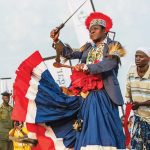African Creatives and a New Kind of Economy
Of late, there has been a rise in the use of the term ‘African creative’. It describes all sorts of global creative practitioners, from established fine artists exhibiting in decades-old galleries to university students selling self-made clothes on Instagram to small ateliers cropping up in cosmopolitan centres selling cultural goods at exorbitant prices. The amorphous nature of the term may be unsettling – indeed, who is a creative if everyone is a creative? However, it also indicates the term’s popularity; if so many are willing to self-describe as African creatives – why? It is not merely a trend but an acknowledgment of the currency the term carries: creativity is now the de facto term to describe the added value that innovation brings to any activity. Lately, this has been acknowledged by public institutions.
From the 20th-23rd June 2023, the inaugural Africa Music, Arts and Culture Exhibition (AMACE23) will take place in Lusaka, Zambia, as part of ongoing festivities organised by the All-African Students Union (AASU) to commemorate their Golden Jubilee. Taking place after this publication goes to print, the full impact of AMACE23 remains unclear; however, its significant public profile – it is being ‘hosted’ by President Hichilema – along with the anticipated volume of functions, speakers, and participants means that the three-day event could potentially be a well-organised and successful one. Set to the theme of ‘Harnessing the Dividends of the African Creative Industry through Investments in Youth Talents’, the AMACE23 exhibitions bring together the Zambian government, local and international cultural, youth, and student organizations, ostensibly seeking to leverage the connection between mobile youth economies and creative practice. AMACE23 can be seen as an affirmation of the new economies that creative practice has enabled worldwide and Africa in particular, and the active role that governments seek in engaging them.

This is most obvious in the tourism industry, the darling child of stable African governments wishing to diversify their economies. Over the past 20 years, tourism has become an important centre of economic activity on the continent. A 2022 report by the International Finance Corporation indicated that 2019 tourism contributed $169 billion to Africa’s economy, accounting for almost 7% of Africa’s GDP. This was down to 3.8% in 2020 due to the outbreak of COVID-19. Thus, many of the tourist industry’s gains in the subsequent two decades were lost, especially in Eastern and Southern Africa. In response, there has been a renewed pledge from African governments to formulate policy centred on reviving the tourism sector. For example, the South African government developed the ‘Tourism Sector Recovery Plan’ very early during the pandemic. In contrast, the Zambian government has continued to reach out to relevant tourist institutions and authorities to offer support.
However, with a few exceptions, these continent-wide efforts often stop at the level of rhetoric. Despite the ongoing constraints of capital markets across the continent, large-scale domestic and foreign investment continues to pour into traditional sectors of the economy, especially in emerging and small tourist markets. In response, African governments seem hopeful that they can ‘Harness’ the ‘Dividends’ with minimal actual financial ‘Investments’, relying on their populations’ ‘entrepreneurial spirit’ instead. Thus, without much formal backing, the tourism industry has had to rely on itself for promotion and development.
African creatives are well-poised to take up the mantle. Much of the tourism we encounter operates on encouragement of the desire to experience: whether it is the desire to experience a new culture, natural landscape, or for some, commodity. In many ways, this parallels the affective appeal of creative experience: art, literature, and food – in short, culture – seek to engage the senses and imagination of an individual and enable the desire for more, often newer experiences. The optics of tourism also mirror the optics with which new creative economies operate – social media platforms operate similarly to tourism advertisements. The entire structure of social media platforms is to gain new users (much like touristic spots), with the attending hashtags, SEO optimisation, and smiling face at this or that beach/ mountain/ restaurant/ retailer to fill in the details.
The African creative adds value to this symbiotic economy through their proximity to African places, experiences, and culture. The African creative is familiar enough to the continent to be a valuable guide for foreign and domestic tourists, which in turn leads to new cultural experiences and expressions for both the tourist and the local. One type of African creative utilizing this function is a new breed of the guidebook: travel vlogging. Similar to travel writers of a past era, travel vloggers record their experiences, feelings, and tips for traveling with their audience through the use of videos and pictures. The casual and accessible nature of these accounts has helped them gain almost-instant popularity among a broad population. The content is usually uncritical and thus garners interest from institutions as a possible avenue for positive press. Take, for example, “akosuashirley”, the Instagram handle of Akosua Shirley, a Ghanaian travel vlogger with 12,000 followers engaged by Ghana Tourism to promote tourism in the country. Her travel ‘content’ includes pictures of tourist attractions within Ghana, alongside adverts from the tourism authority. Other creatives are more subtle: another Ghanaian travel vlogger, Jasmine Ama – with 130,000 YouTube subscribers – produces video ‘content’ for an African diaspora market, and her videos re-enact African culture for African ex-pats. Ama is not engaged by Ghana tourism, but her videos certainly promote Ghana as a tourist destination – as of 2020, tourism contributed over $3.1 billion to its economy, up from $118 million in 1991.
AMACE23 – and similar efforts by African governments – hope to replicate what the Ghanaian tourism industry has achieved. Leveraging African creatives and content creators is a relatively affordable alternative to more capital-intensive tourism schemes. It has the added benefit of promoting African culture. However, as with the travel writers of old, one wonders whether African creatives will be able to withstand the temptation of using misrepresenting African culture: framed within the context of tourism that wishes more and more to consume culture as a commodity, can there truly be creative activity whose added value is not an African stereotype?



